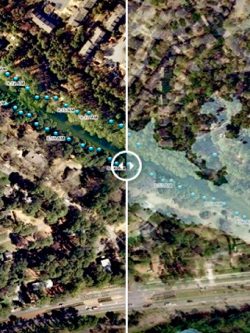VIMS will once again help “Catch the King”
Researchers use tide data from citizen scientists to improve flood models
The second annual “Catch the King” event—when trained volunteers hit the shores of Hampton Roads to map the reach of one of the year’s highest astronomical tides—will take place this Saturday morning, October 27th.
The event—brainchild of former Virginian-Pilot reporter Dave Mayfield, Skip Stiles of local non-profit Wetlands Watch, and Dr. Derek Loftis of the Virginia Institute of Marine Science—is designed to raise awareness of coastal flooding and sea-level rise by giving participants a firsthand look at a troubling reality: in just 50 years, regular high tides will be as high as today’s annual “king tides,” while king tides will reach heights now only seen during storms.
“We care about king tides because they're harbingers of what's to come in the decades ahead,” says Mayfield. “They are a window into that future.”
{{youtube:medium|agP9qorZhlg, Learn all about this year's Catch the King event from the King himself in this video from WHRO.}}
The event also provides a wealth of water-level data that Loftis uses to improve VIMS’ street-level inundation model, a computer simulation that builds on data from a network of water-level sensors to predict the time and place of coastal flooding throughout Hampton Roads—from the broad shorelines of the Chesapeake Bay to the narrowest tidal creeks. Participation in the event is just one part of VIMS’ institute-wide effort to help Virginia and other coastal areas become more resilient to coastal flooding and sea-level rise.
“Catch the King” participants gather their data using the free “Sea Level Rise” app developed by Stiles in conjunction with Norfolk-based software development company Concursive. The app now includes changes suggested by Loftis and Norfolk’s Deputy Resilience Officer Kyle Spencer that help scientists better interpret the data provided by volunteers during flood events. With phones in hand, these “king’s attendants” walk along the water line near peak tide, thumbing a “GPS pin” every few strides to mark the extent of tidal inundation.
“The app gives us an easy way to map the entirety of Hampton Roads,” says Loftis. “Last year, about 700 volunteers collected nearly 60,000 GPS points for geospatial comparison throughout Tidewater Virginia, which enabled us to validate our model across the region.”
For Loftis, that validation involves a painstaking, cell-by-cell comparison of predicted and observed water levels. He says “We take the GPS values from the app, and the 1.2 million individual grid cells in our model, and compare the time series of what was observed and what was predicted. We then use any discrepancies to help improve the model.”
{{youtube:medium|3J9VtXM7hBQ, Learn how Dr. Derek Loftis uses data collected by volunteers during Catch the King events to validate VIMS' street-level flood model.}}
Loftis even created a tool that allows Catch the King participants to check the validation themselves. “We built an online map that lets people measure between any of their points and what our model predicted as the maximum inundation extent,” he says. “They can use the online measuring tools to see in feet any difference between what they recorded as the high-water line and what the model predicted.”
The differences typically stem not from any problem with the physics the model uses to simulate changes in water level, but from inaccuracies in elevation data. Although LIDAR technology—which uses aircraft-mounted lasers to map ground height—has greatly improved elevation maps in Virginia and around the world, some terrain types still pose problems. “LIDAR can’t see through thick tree cover, or under bridges or though culverts,” says Loftis, “so we need people to visit these trouble spots in person.”
Loftis says this is where Catch the King’s media partners—The Virginia Pilot, Daily Press, WHRO, and WVEC—play a particularly important role. “We’ve collected data since 2014 using the Sea Level Rise app,” he says, “but without media support, everyone tends to go to the one place they know floods—the Hague in Norfolk, for instance. Our media partners are critical in letting people know not to collect data just in the places we already know have issues, but to spread out to areas where model validation is most needed.”

One such model-validation hot spot is what Loftis calls an “artificial digital dam.” These occur where LIDAR-based data show the local elevation as the pavement level of a bridge—rather than the river, creek, or culvert underlying that surface. If not corrected, these features will prevent the model from extending floodwaters upstream of the perceived obstruction, thus greatly underestimating the actual extent of inundation. “Ground-truthing” by Catch the King volunteers can rectify the sometimes large discrepancies occasioned by these virtual features; mapping the upstream flood extent is thus a focus area for this year's volunteer participants.
This year, WHRO is focusing its outreach efforts on schools, with more than 120 elementary, middle, and high schools having chosen Catch the King as their science class project. The event touches on six major SOLs, including physics, geometry, chemistry, and water quality.
Although registration to participate in this year’s Catch the King event is now closed, the Sea Level Rise app is available at any time through Apple’s App Store and Google Play, and training sessions will continue to prepare users for future high-tide and storm events.
“The 2018 Catch the King event will again serve as our annual dress-rehearsal for learning how to map the extent of a flood event during safe, blue-sky conditions,” says Loftis. “This way, app users will be prepared for mapping water levels during more significant floods, whether they’re caused by hurricanes, nor'easters, heavy rainfall, or wind tides.”
Supporting the Catch the King event is the Commonwealth Center for Recurrent Flooding Resiliency, a partnership between VIMS, Old Dominion University, and the Virginia Coastal Policy Center at W&M Law School. Other sponsors include the Batten Environmental Education Initiative, the Hampton Roads Community Foundation, the Hampton Roads Sanitation District, and tHRive, the young professionals of the Hampton Roads Chamber.

